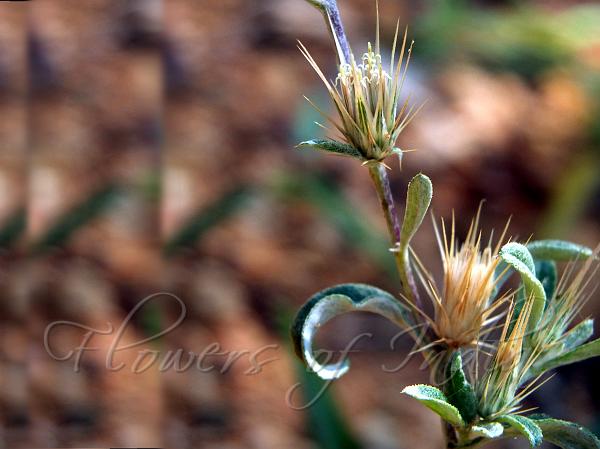|
| Woolly Dicoma |
|

|

| File size | 783757 |
| Original date | 10/25/15 1:07 PM |
| Resolution | 2048 x 1536 |
| Flash | Flash did not fire, auto |
| Focal length | 34.9mm |
| Exposure time | 1/800s |
| Aperture | 4.5 |
| Focus Distance | |
| Metering Mode | Average |
| Camera make | FUJIFILM |
| Camera model | X-S1 |
| Sensor type | OneChipColorArea |
|
|
|
|
Photo: |
Botanical name: Dicoma tomentosa Family: Asteraceae (Sunflower family)
Synonyms: Acilepis lanata, Dicoma gnaphaloides, Dicoma lanuginosa
Synonyms: Acilepis lanata, Dicoma gnaphaloides, Dicoma lanuginosa
Woolly Dicoma is an erect, white wooly, annual
herb, growing up to 7.5-31.0 cm tall, woody at base. Stem is round,
much branched, tinged purplish. Leaves are stalkless, blade tapering at
base, linear, linear-lanceshaped, oblong-inverted-lanceshaped, surfaces
densely white, wooly below sparsely wooly above, margins serrulate or
entire. Flower-heads are numerous, stalkless or shortly stalked,
involucral bracts are 4-5 seriate, overlapping, rough, pale-yellow,
brownish-tinged spines, linear-oblong, margins scarious. Flowers are
tubular-bell-shaped, tube 5 lobed, divided more than half of the flower
length, pointed, curled. Anthers barbellate, tip pointed. Style 0.5 cm
long, cypsels pale-brown, 10-ribbed, base wedge-shaped, densely
silky-hairy. Flowering: September-October.
Medicinal uses: Root is used for toothache.
Whole plant is useful in febrile attacks to which women are prone to
after child birth. The plant is applied as a dressing to septic wounds,
and is used in a fumigation to relieve skin-itch. The leaves and fruit
are burnt in a hole over which the patient squats when treating pain in
the testicles.
Root is used for toothache.
Whole plant is useful in febrile attacks to which women are prone to
after child birth. The plant is applied as a dressing to septic wounds,
and is used in a fumigation to relieve skin-itch. The leaves and fruit
are burnt in a hole over which the patient squats when treating pain in
the testicles.
Medicinal uses:
 Root is used for toothache.
Whole plant is useful in febrile attacks to which women are prone to
after child birth. The plant is applied as a dressing to septic wounds,
and is used in a fumigation to relieve skin-itch. The leaves and fruit
are burnt in a hole over which the patient squats when treating pain in
the testicles.
Root is used for toothache.
Whole plant is useful in febrile attacks to which women are prone to
after child birth. The plant is applied as a dressing to septic wounds,
and is used in a fumigation to relieve skin-itch. The leaves and fruit
are burnt in a hole over which the patient squats when treating pain in
the testicles. | Identification credit: Navendu Pāgé | Photographed in Anantapur District, Andhra Pradesh. |
• Is this flower misidentified? If yes,